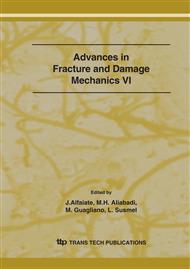p.489
p.493
p.497
p.501
p.505
p.509
p.513
p.517
p.521
A Numerical Method for Predicting the Chloride Diffusivity of Concrete with Interfacial Cracks
Abstract:
Due to its importance to the durability assessment of reinforced concrete structures located in a marine or de-icing salt environment, it is essential to determine the chloride diffusivity of concrete. This paper presents a numerical method for predicting the chloride diffusivity of concrete with interfacial cracks. By modeling concrete as a three-phase composite material composed of aggregate, interfacial transition zone and cement paste, a composite circle model with an interfacial crack located on the aggregate surface is constructed. The finite element method is used to solve the composite circle under a given boundary condition and the chloride diffusivity of concrete is then determined numerically. After verifying the numerical method with experimental results obtained from the literature, the effect of interfacial cracks on the chloride diffusivity of concrete is evaluated in a quantitative manner. It is found that the chloride diffusivity of concrete increases with the increase of the subtended angle of interfacial cracks. The paper concludes that the numerical method presented in this paper can predict the chloride diffusivity of concrete with reasonable accuracy.
Info:
Periodical:
Pages:
505-508
Citation:
Online since:
September 2007
Authors:
Price:
Сopyright:
© 2007 Trans Tech Publications Ltd. All Rights Reserved
Share:
Citation:


